Southwaite WwTW (2022)
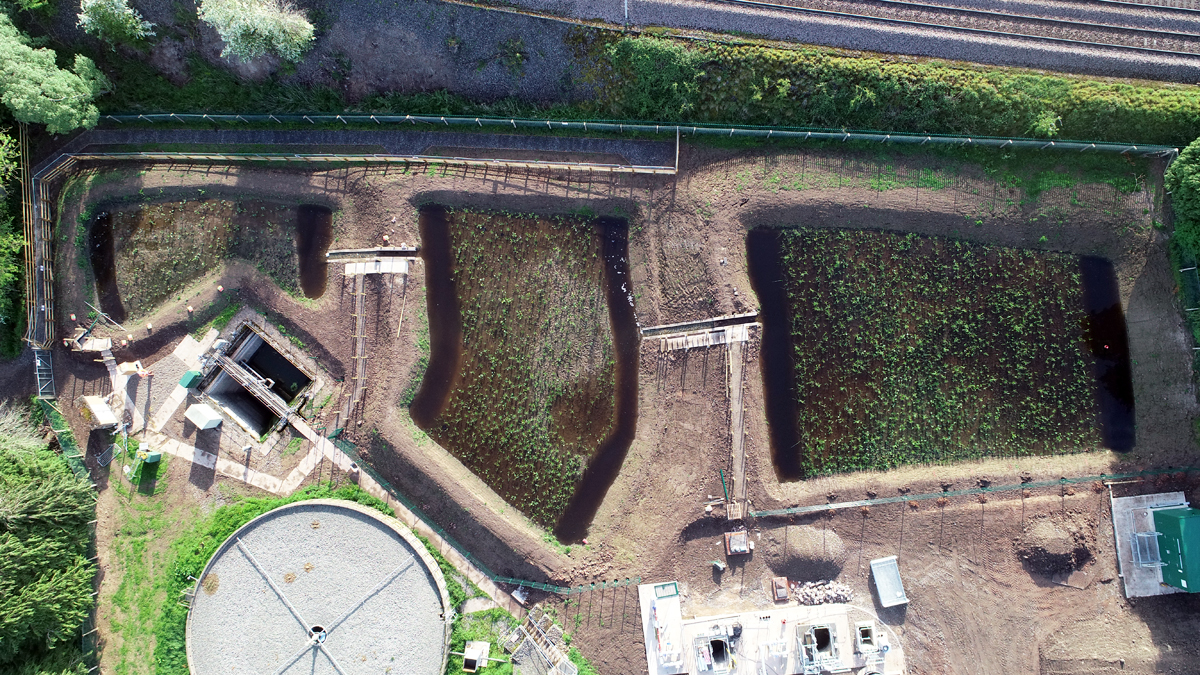
Southwaite WwTW showing the wetland in its first season of maturation: May 2022 - Courtesy of Advance-plus
Southwaite is a small rural village in Cumbria about 5 kilometres south of Carlisle. The works treats a population of about 1,000 from the village and the nearby M6 Motorway Services. The existing trickling filter works had reached the end of its asset life and needed to be upgraded. In a first of its kind for United Utilities a nature-based integrated constructed wetland has been constructed to treat stormwater at Southwaite Wastewater Treatment Works (WwTW). As part of the upgrade, a new treatment works with a conventional process stream of screening and grit removal, primary settlement, submerged aerated filters, secondary settlement, and sludge management was constructed.
Nature-based stormwater treatment
Capital delivery partner Advance-plus (a joint venture between MWH Treatment, Murphy Group and Stantec UK) worked with United Utilities to assess the options for stormwater treatment.
The traditional approach of constructing storm tanks was considered but discounted because of its high embodied carbon and concerns with septicity build-up, due to extensive retention times prior to storm flows being able to be returned to the works. Keen to minimise embodied and operational carbon, United Utilities and Advance-plus assessed more nature-based treatment solutions.
Initially vertical flow aerated reed beds and horizontal flow reed beds were proposed. However, the vertical flow aerated reed beds require mechanical blowers to provide aeration into the reed bed to aid the treatment process. The embodied carbon and ongoing operational power requirements led the team to propose a wetland for the treatment of stormwater. A conventional horizontal flow reed bed was also considered however, the enhanced biodiversity of the integrated constructed wetland was a major contributing factor in the final decision to select this method of treatment.
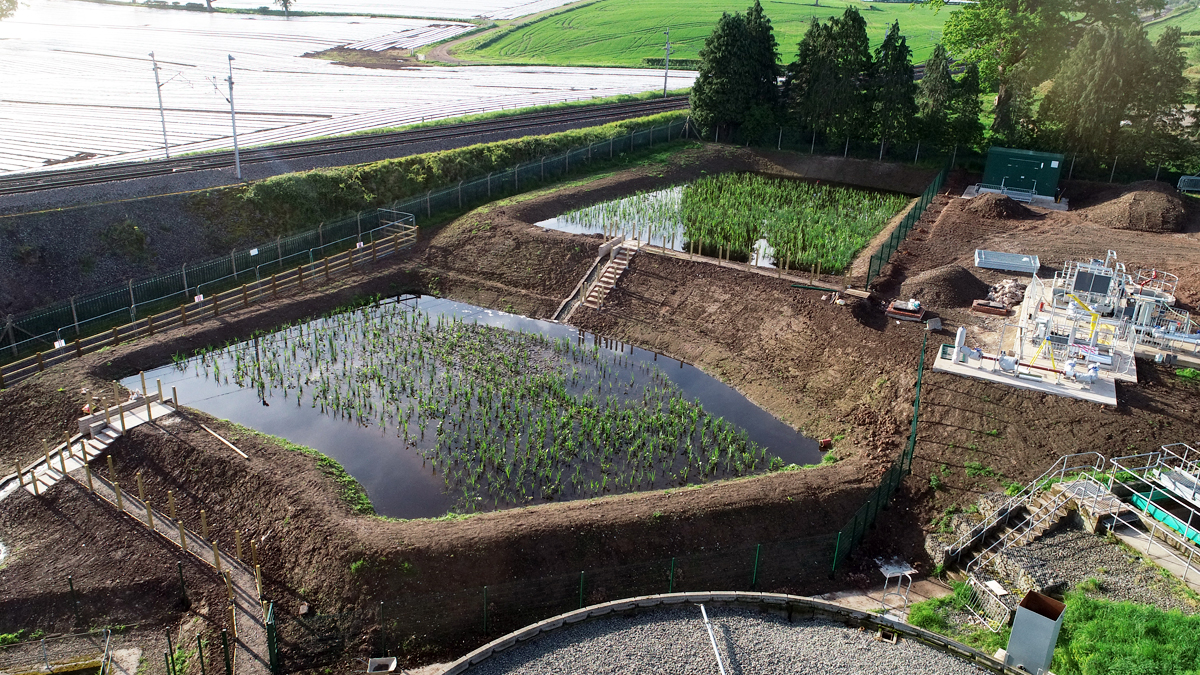
Integrated wetland after planting: March 2022 – Courtesy of Advance-plus
Southwaite WwTW: Supply chain – key participants
- Main contractor: Advance-plus
- J Murphy & Sons
- MWH Treatment
- Wetland designer: Stantec UK
- Wetland construction: Waitings Ltd
- Reeds & other plants: Salix River and Wetland Services
- Civil engineering: Cubby Construction Ltd
- Inlet screens: Huber Technology
- Tanks: Stortec Engineering Ltd
- RAM Pumps: EMS Industries Ltd
- Temporary works: MGF UK
Integrated constructed wetland
The space available for the Integrated constructed wetland was constrained to the spare land available between the site boundary to the east and the operational process units to the west. As the eastern boundary has the West Coast Mainline railway line adjacent its construction required regular consultation with Network Rail. The topography of the available land was ideally suited to allow a 3-cell design, with a total surface area of 1,300m2, with flows cascading between the ponds.
Each cell is 500mm deep and designed to create a marshy wetland. The majority of the wetland is filled with 300mm of soil, recycled from the construction of the main works, and 200mm water depth. At the head and end of each cell is a 500mm deep ‘baron’ or unplanted area to dissipate energy from the incoming flows and ensure even distribution of flow across the wetland. The configuration incorporates a cascade between each cell to provide natural aeration of the stormwater. Although not typically required, these cells are complimented with a geotextile waterproof membrane to eliminate the risk of undermining the West Coast Mainline. The embankments are natural using material from the site and planted with a wildflower seed mix.
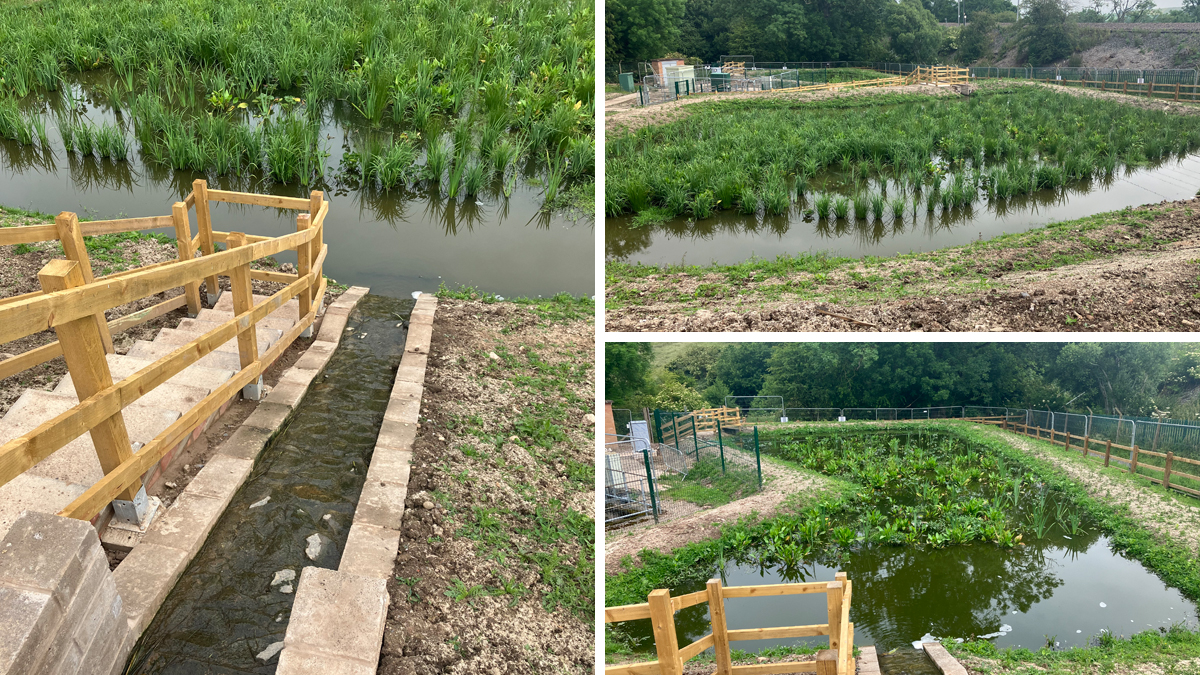
Southwaite WwTW: Integrated wetland – Pond 1 – Courtesy of Courtesy of Advance-plus
The plants in the wetland were carefully selected to give maximum treatment capacity and biodiversity. The first cell has very hardy dominant species (reeds/rushes) which are ideal for sanitary wastewater. The second cell starts to blend in more specific diverse plants and thin out the more hardy reeds, with Cell 3 to an even greater extent. The planting ratio was 9 plants/m2. Through discussions with the ICW specialists it is anticipated the plants will take 2-3 full growing seasons to attain maturity, although effective treatment will begin almost immediately. To accelerate the treatment process, Advance-plus engaged RSK company Salix River and Wetland Services to grow the plants in their nursery over the Winter of 2021/22 so they were more established ahead of planting at Southwaite in Spring 2022.
Over time it is expected that the maintenance of the wetland will be minimal with natural evolution of the plant species which will dominate in each of the cells. To keep the wetland from stagnating during prolonged periods of dry weather a recirculation system has been incorporated into the design diverting treated effluent from the main works through the wetland. If the storm event duration monitor (EDM) detects a storm flow occurring the recirculation flow is stopped and the main flow from the works discharged directly to the receiving watercourse to the appropriate consent levels.
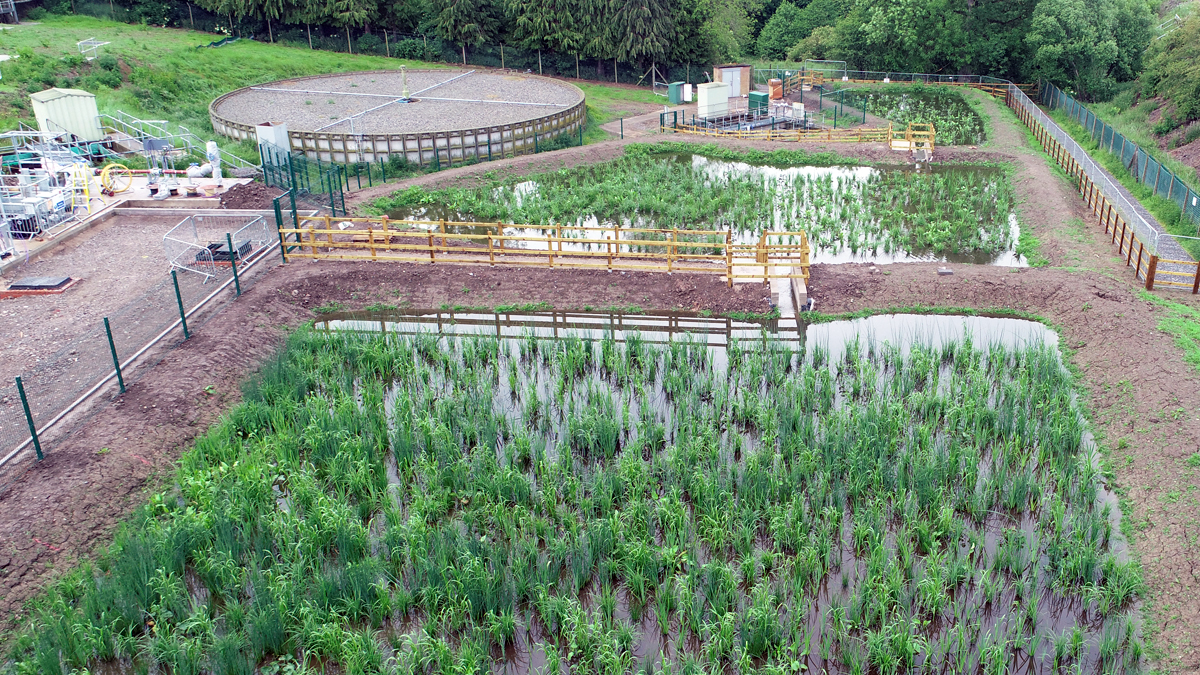
Overview of ponds after 3 months: June 2022 – Courtesy of Advance-plus
Main wastewater treatment stream
Network flows arrive at the site and are immediately directed to the preliminary treatment phase of the treatment works. This is in the form of an industry-wide 6mm, two-dimensional fine screen utilised on small rural works. Debris is lifted out of the influent and washed before compaction and disposal into a skip for removal off site. Once the influent has passed through the fine screen it enters a chamber design to reduce the velocity of the flow and allow heavy particulates or grit to fall and settle on the base. Periodically a tanker will attend site and extract the settled grit and remove it off site.
Due to the topography of the site, it is now required to pump forward up to two upflow primary settlement tanks at the same time as dosing iron salts to promote strong settlement of solids. Water is decanted from the top of the settlement tank and passed to the next stage of treatment, whilst the settled sludge is periodically pumped from the base of the conical tank to a sludge holding tank for further treatment.
As flow passes through the submerged aerated filter cells biological treatment occurs as the ‘good bacteria’ that lives on plastic media inside the cells feed on the water pollutants and create a biomass which can them be removed during the next process stage. The growth of the biomass is accelerated using compressed and diffused fine air bubbles.
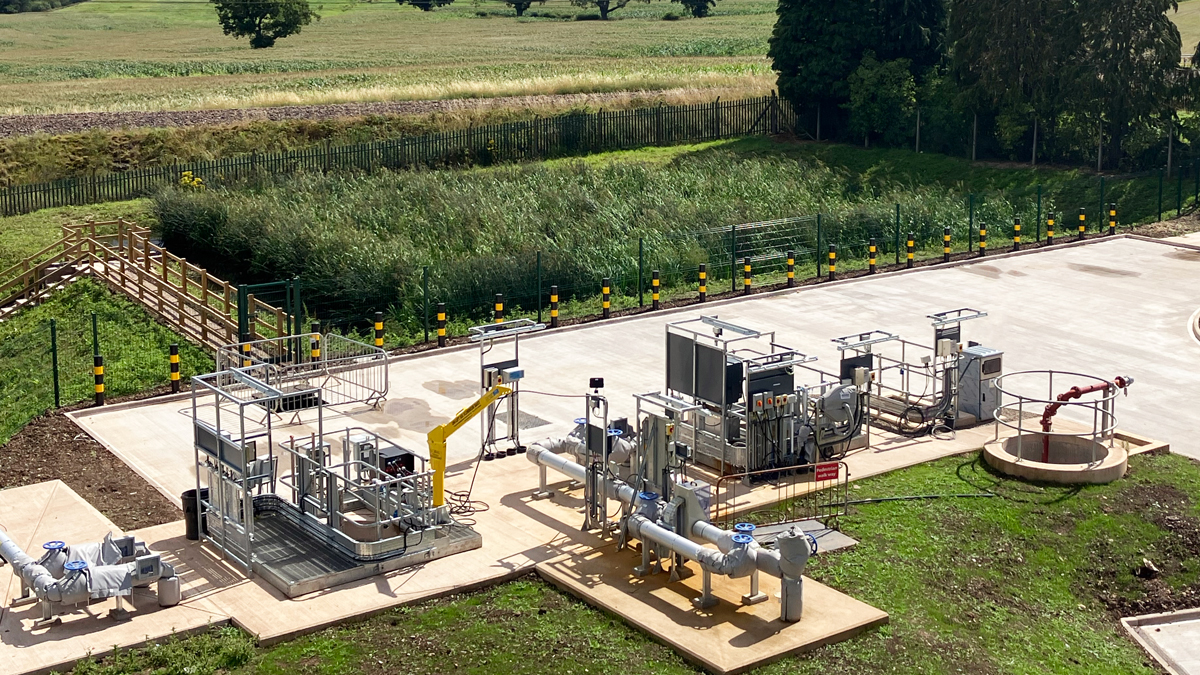
Southwaite WwTW – Cell 1 in background – Courtesy of Advance-plus
The last stage of treatment is to pass the flow through two upflow final settlement tanks. As with the primary tanks clean water is now decanted off the top and discharged to the local watercourse after being sampled to ensure it complies with the permits as set out by the Environment Agency. The much thinner settled sludge from the final tanks is this time recirculated to mix with new influent at the PSTs and passes through the treatment stream.
Once the primary sludge has been pumped to the sludge holding tank it is allowed to settle for a period before the top water or supernatant is decanted and pumped back to the beginning of the treatment process. The residual thickened/dewatered sludge is finally tankered off site to a local sludge digestion plant for conversion to a liquid gas fuel.
Delivering social value
Recognising the natural capital social value of nature-based solutions, United Utilities were keen to make the wetland as accessible as possible to the public. As part of the project low level fencing, footpaths and viewing areas have been added to encourage local engagement with the wildlife as it establishes itself over the next few years.
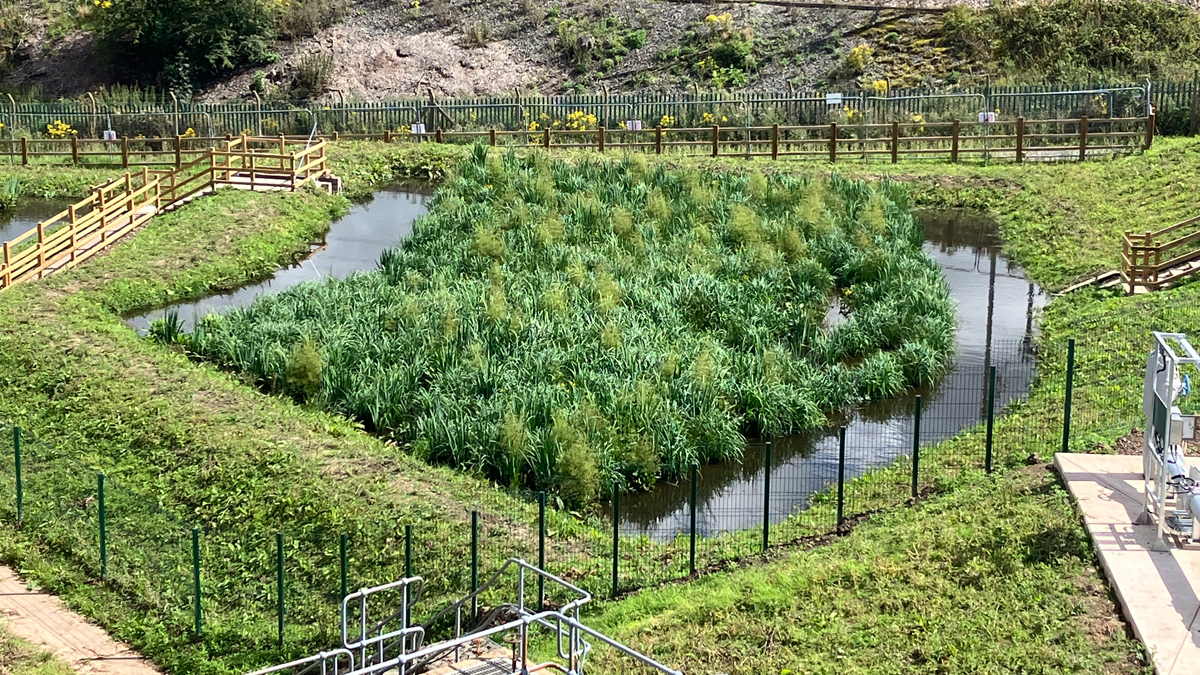
Cell 1: June 2022 – Courtesy of Advance-plus









